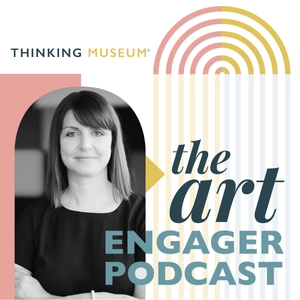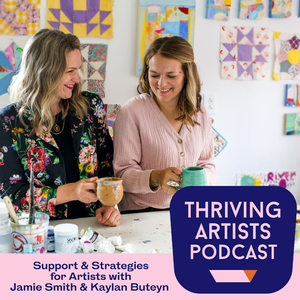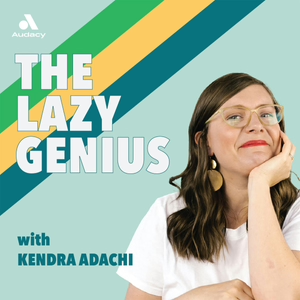
3 New Thinking Routines to Try in Your Museum and Gallery Programmes
03/23/23 • 22 min
1 Listener
Are you tired of using the same old thinking routines in your museum and gallery programmes? Maybe it's time to try something new? In this week’s episode, I'm sharing three exciting thinking routines that you can add to your repertoire.
These routines will help you engage your audience and encourage them to think creatively about art and objects.
- Start with the basics: building a repertoire of thinking routines.
- Experiment and try new thinking routines to stay curious and inspired.
- Three new thinking routines to try out: Imagine If, Take Note, and Creating Space for Learning
- Imagine If: a thinking routine for looking closely, finding opportunity, and pursuing new ideas.
- Take Note: a thinking routine for distilling ideas in response to a piece of art or an object.
- Creating Space for Learning: a thinking routine that is essentially a grounding exercise that helps us to prepare for any programme, class or task.
Three new thinking routines for you to try out. I hope you find them helpful in engaging your audience with art and objects in a new and exciting way.
Links
EPISODE WEB PAGE
Episode 6 - 6 Essential Thinking Routines You Need in your Repertoire
Episode 16 - How to use See Think Wonder in your Art Discussions
Episode 57 - How to End Well
Episode 59 - 9 Thinking Routines to Improve your Powers of Observation
Download the Ultimate Thinking Routine List
Join the Slow Looking Club Community on Facebook
Download the NEW resource - how to look at art (slowly)
Curated newsletter by Claire Bown
Are you tired of using the same old thinking routines in your museum and gallery programmes? Maybe it's time to try something new? In this week’s episode, I'm sharing three exciting thinking routines that you can add to your repertoire.
These routines will help you engage your audience and encourage them to think creatively about art and objects.
- Start with the basics: building a repertoire of thinking routines.
- Experiment and try new thinking routines to stay curious and inspired.
- Three new thinking routines to try out: Imagine If, Take Note, and Creating Space for Learning
- Imagine If: a thinking routine for looking closely, finding opportunity, and pursuing new ideas.
- Take Note: a thinking routine for distilling ideas in response to a piece of art or an object.
- Creating Space for Learning: a thinking routine that is essentially a grounding exercise that helps us to prepare for any programme, class or task.
Three new thinking routines for you to try out. I hope you find them helpful in engaging your audience with art and objects in a new and exciting way.
Links
EPISODE WEB PAGE
Episode 6 - 6 Essential Thinking Routines You Need in your Repertoire
Episode 16 - How to use See Think Wonder in your Art Discussions
Episode 57 - How to End Well
Episode 59 - 9 Thinking Routines to Improve your Powers of Observation
Download the Ultimate Thinking Routine List
Join the Slow Looking Club Community on Facebook
Download the NEW resource - how to look at art (slowly)
Curated newsletter by Claire Bown
Previous Episode

How to Create Intellectual Comfort
Today I’m exploring the concept of creating intellectual comfort in your museum and gallery programmes.
In my (forthcoming) book Slow Looking at Art: The Visible Thinking in the Museum Approach I have a chapter dedicated to creating a collaborative culture in your museum and gallery programmes. As part of this chapter, I talk about how important it is to make participants feel not only psychologically safe, but also intellectually safe.
Museums can be intimidating spaces. And this is particularly prevalent in art museums and around art in general. So many people feel that museums are not places for them, that there is a prerequisite amount of information required before you can enjoy being in a museum.
Your job as a facilitator is to ensure that everyone feels confident and able to participate fully in your programme, whatever their motivation or knowledge level upon arriving. This is what it means to create intellectual comfort on a museum or gallery programme.
In today's episode, I'm exploring what intellectual comfort is, why it's important and 8 ways you can foster it in your programmes.
Links
Episode 74 - How to Enjoy Art (without knowing anything about it)
Episode 44 - The 4 elements of a great introduction
Episode 48 - 10 types of questions you should never ask
Download the Ultimate Thinking Routine List
Join the Slow Looking Club Community on Facebook
Download the NEW resource - how to look at art (slowly)
Curated newsletter by Claire Bown
Articles quoted on Intellectual Safety:
Critical Communities: Intellectual Safety and the Power of Disagreement - Ashby Butnor
https://files.eric.ed.gov/fulltext/EJ1005647.pdf
The Importance of Intellectually Safe Classrooms for Our Keiki - Trevor Baba https://files.eric.ed.gov/fulltext/EJ1237572.pdf
Next Episode

Improving Mental Health and Wellbeing Through Art with Heather Thomas
In Episode 92, I'm chatting to Heather Thomas, the Head of Learning and Engagement at the Lightbox Museum and Gallery in Woking, UK.
Heather talks about how their Art and Wellbeing programme of creative and therapeutic workshops provides opportunities for those that would otherwise not be able to access arts and heritage services.
We discuss the guiding principles behind the Lightbox Museum and Gallery's work in learning and engagement, which has always included helping people with mental health issues or those who are isolated.
We also discuss what the Open Mind project is and how it provides a safe space for individuals to come and learn something new, chat with others and engage with art.
We talk about how Open Mind tours prioritise connection over content and are wholly participant-led, open conversations that take their cues directly from the participants, not the facilitator.
Finally, we talk about the positive outcomes of the programme and the Lightbox's plans for the future.
Links
Lightbox website: www.thelightbox.org.uk
Museums Journal (Museums Association UK) article: https://www.museumsassociation.org/museums-journal/analysis/2022/11/its-time-for-museums-to-address-mental-health/
Baring report: https://baringfoundation.org.uk/resource/creatively-minded-at-the-museum/
Mind: https://www.mind.org.uk/
Catalyst: https://www.catalystsupport.org.uk/
If you are struggling, please contact Samaritans https://www.samaritans.org/
Young Minds website for children and young people: https://www.youngminds.org.uk/
If you like this episode you’ll love
Episode Comments
Generate a badge
Get a badge for your website that links back to this episode
<a href="https://goodpods.com/podcasts/the-art-engager-245896/3-new-thinking-routines-to-try-in-your-museum-and-gallery-programmes-28872788"> <img src="https://storage.googleapis.com/goodpods-images-bucket/badges/generic-badge-1.svg" alt="listen to 3 new thinking routines to try in your museum and gallery programmes on goodpods" style="width: 225px" /> </a>
Copy




